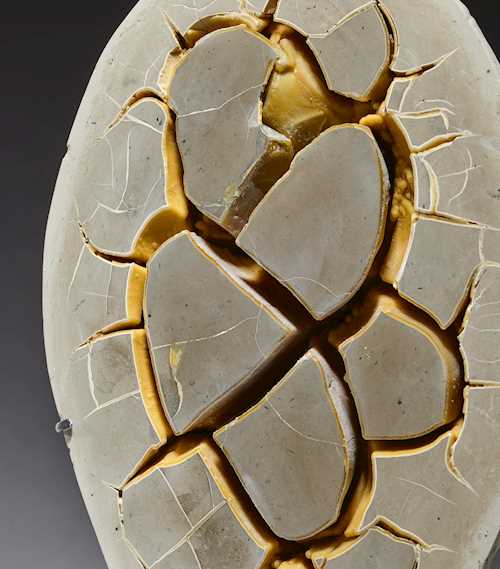
Lot 912* - S18 Out of This World - Dienstag, 18. April 2023, 16.00 Uhr
ZWEI SEPTARIEN
Oligozän
50–70 Millionen Jahre
Belgien
39 × 33 × 6 cm (ohne Ständer)
Mit massgefertigten Metallständern
50–70 Millionen Jahre
Belgien
39 × 33 × 6 cm (ohne Ständer)
Mit massgefertigten Metallständern
Septarian nodules are fossilised mud bubbles or round concretions found in sedimentary rocks, formed between 50 and 70 million years ago. Septarian is classed as a rock and not as a mineral. Concretions are hard solid masses formed by the accumulation of matter with sediment. Scientists do not agree on the details and specifics of their formation, but there are several theories. One is that they formed as a result of dehydration and shrinkage of clay, gel or organic cores within sedimentary pockets. Others believe there was an expansion of gases produced by the decay of organic matter that fractured material within sedimentary pockets. Another theory suggests that an earthquake compaction or other geologic forces fractured material within sedimentary pockets.
Whatever the cause, the sedimentary material fractured and mineral-rich fluids filled the spaces between the breaks, allowing calcite, siderite, pyrite and other minerals to crystallise in the open areas within the cavity. It is almost like the Japanese Kintsugi repair method for ceramics, in which pulverised gold powder is inserted into the cracks of a broken object to make it relive again in a mesmerizing fashion.
This fabulous example shows two almost identical septarian nodules, two concretions of rock, formed into egg-shaped natural sculptures and mounted on elegant plain metal stands. The surface is cracked open, evoking a mystical feeling. The colour scale is fabulous with its greyish, earth-tone and sand-coloured areas creating a soothing atmosphere. The combination of minerals makes for an interesting contrast in texture as well as colour.
This is a beautiful and special addition to a collection of geological curiosities for any treasure hunter.
Whatever the cause, the sedimentary material fractured and mineral-rich fluids filled the spaces between the breaks, allowing calcite, siderite, pyrite and other minerals to crystallise in the open areas within the cavity. It is almost like the Japanese Kintsugi repair method for ceramics, in which pulverised gold powder is inserted into the cracks of a broken object to make it relive again in a mesmerizing fashion.
This fabulous example shows two almost identical septarian nodules, two concretions of rock, formed into egg-shaped natural sculptures and mounted on elegant plain metal stands. The surface is cracked open, evoking a mystical feeling. The colour scale is fabulous with its greyish, earth-tone and sand-coloured areas creating a soothing atmosphere. The combination of minerals makes for an interesting contrast in texture as well as colour.
This is a beautiful and special addition to a collection of geological curiosities for any treasure hunter.
CHF 2 000 / 3 000 | (€ 2 060 / 3 090)
Verkauft für CHF 6 250 (inkl. Aufgeld)
Angaben ohne Gewähr


